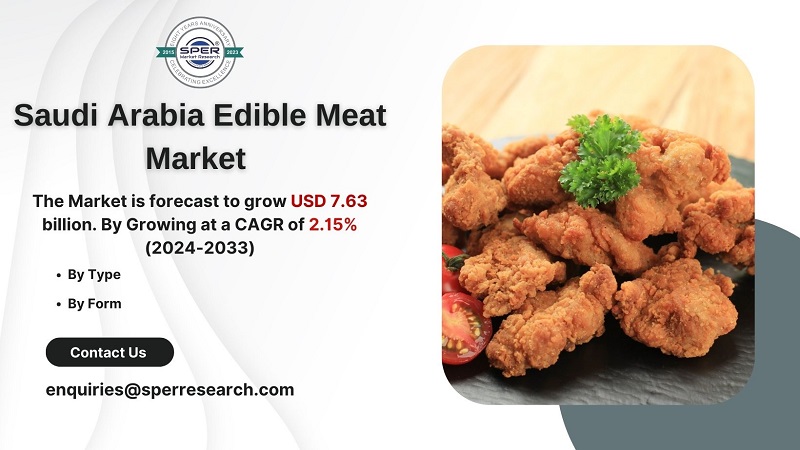Saudi Arabia Edible Meat Market Growth and Size Rising Trends, Demand, Revenue, CAGR Status, Challenges, Future Opportunities and Forecast Analysis till 2033: SPER Market Research

Edible meat includes a wide spectrum of animal-derived products that are considered safe and suitable for human consumption. In recent years, the definition of edible meat has expanded to include plant-based meat substitutes and lab-grown (cultured) meat. These products aim to match the taste, texture, and nutritional content of traditional meat while simultaneously addressing concerns about environmental sustainability, animal welfare, and food security. Different types of meat are classed according to the animal source, such as beef from cattle, pork from pigs, poultry from chickens and other birds, and mutton or lamb from sheep. Each type of meat has various nutritional properties, including vital components such as protein, vitamins, and minerals, including iron and B vitamins, which are required for a healthy diet.
According to SPER Market Research, ‘Saudi Arabia Edible Meat Market Size- By Type, By Form, By Distribution Channel – Regional Outlook, Competitive Strategies and Segment Forecast to 2033’ states that the Saudi Arabia Edible Meat Market is estimated to reach USD 7.63 billion by 2033 with a CAGR of 2.15%.
Drivers:
Saudi Arabia’s rapidly growing population, combined with increased urbanization, is a significant driver of the edible meat industry. As the population increases, so does the demand for food, particularly meat. Urbanization produces lifestyle changes that frequently result in higher meat consumption, especially in cities where people have more disposable income and access to a wider variety of food options. Saudi Arabia’s ongoing economic success, fuelled by its oil wealth and economic diversification efforts, has resulted in higher disposable incomes. This economic gain has enabled more customers to afford meat on a regular basis, causing dietary trends to shift toward higher protein consumption, including various types of meat. The expansion of modern retail formats such as supermarkets and hypermarkets has also increased demand for convenient, high-quality beef products.
Restraints:
The Saudi government has strict regulations in place to assure food safety, halal certification, and meat product quality. While these standards ensure customer safety and respect to Islamic dietary laws, they also provide significant challenges for producers and importers. Meeting these legal requirements can be costly and time-consuming, particularly for smaller businesses. Noncompliance can lead to product recalls, fines, or bans, reducing market players’ profitability and share. Consumer tastes in Saudi Arabia are gradually shifting as health consciousness and awareness of sustainable food sources rise. There is also growing interest in plant-based diets and alternative protein sources, such as plant-based or lab-grown meat, which may have an impact on the traditional meat market and present a challenge to traditional meat producers who must adapt to changing consumer demands.
Request for Free Sample Report @ https://www.sperresearch.com/report-store/saudi-arabia-edible-meat-market.aspx?sample=1
The Covid-19 epidemic disrupted both global and local supply chains, reducing the availability of animal products in Saudi Arabia. The country’s reliance on meat imports, primarily from Brazil, India, and Australia, made it vulnerable to global supply chain disruptions. Lockdowns, transportation restrictions, and labor shortages in exporting countries hindered meat supplies, causing temporary shortages and increased prices in the domestic market. It has also driven up the cost of producing both domestic and imported beef. Domestically, the difficulty of obtaining feed, labor constraints, and the requirement to set demanding health and safety regulations in processing facilities all contributed to higher manufacturing costs.
Riyadh dominates Saudi Arabia’s edible meat market. This supremacy arises primarily from its role as the country’s capital and largest city, which results in a larger population density, higher disposable incomes, and increased demand for a wide range of meat products. Major players in the market are- as Al-Watania Poultry, Almarai Food Company, BRF S.A, Golden Chicken Farm Factory Company, and Others.
Saudi Arabia Edible Meat Market Segmentation:
By Type: Based on the Type, Saudi Arabia Edible Meat Market is segmented as; Beef, Mutton, Poultry, Other Meat.
By Form: Based on the Form, Saudi Arabia Edible Meat Market is segmented as; Canned, Fresh/Chilled, Frozen, Processed.
By Distribution Channel: Based on the Distribution Channel, Saudi Arabia Edible Meat Market is segmented as; Convenience Stores, Online Channel, Supermarkets and Hypermarkets, Other.
By Region: Based on the Region, Saudi Arabia Edible Meat Market is segmented as; Riyadh, Jeddah, Dammam, Rest of Saudi Arabia.
For More Information, refer to below link: –
KSA Edible Meat Market Outlook
Related Reports:
Follow Us –
LinkedIn | Instagram | Facebook | Twitter
Contact Us:
Sara Lopes, Business Consultant – USA
SPER Market Research
+1-347-460-2899





